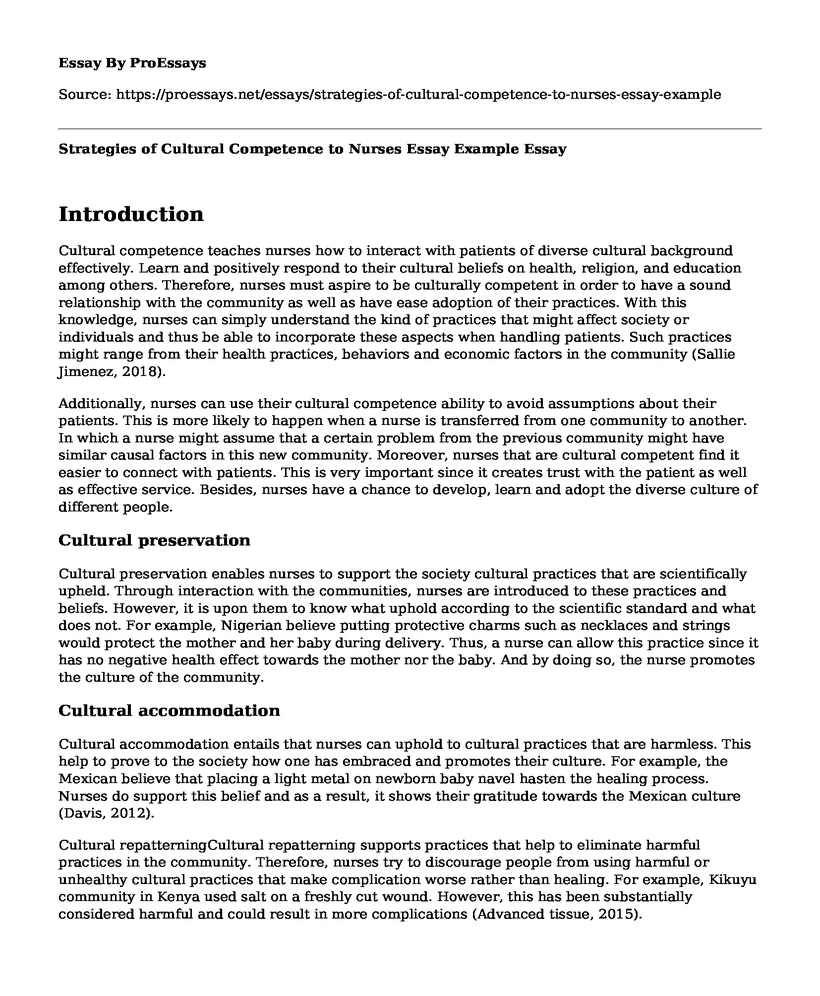Introduction
Cultural competence teaches nurses how to interact with patients of diverse cultural background effectively. Learn and positively respond to their cultural beliefs on health, religion, and education among others. Therefore, nurses must aspire to be culturally competent in order to have a sound relationship with the community as well as have ease adoption of their practices. With this knowledge, nurses can simply understand the kind of practices that might affect society or individuals and thus be able to incorporate these aspects when handling patients. Such practices might range from their health practices, behaviors and economic factors in the community (Sallie Jimenez, 2018).
Additionally, nurses can use their cultural competence ability to avoid assumptions about their patients. This is more likely to happen when a nurse is transferred from one community to another. In which a nurse might assume that a certain problem from the previous community might have similar causal factors in this new community. Moreover, nurses that are cultural competent find it easier to connect with patients. This is very important since it creates trust with the patient as well as effective service. Besides, nurses have a chance to develop, learn and adopt the diverse culture of different people.
Cultural preservation
Cultural preservation enables nurses to support the society cultural practices that are scientifically upheld. Through interaction with the communities, nurses are introduced to these practices and beliefs. However, it is upon them to know what uphold according to the scientific standard and what does not. For example, Nigerian believe putting protective charms such as necklaces and strings would protect the mother and her baby during delivery. Thus, a nurse can allow this practice since it has no negative health effect towards the mother nor the baby. And by doing so, the nurse promotes the culture of the community.
Cultural accommodation
Cultural accommodation entails that nurses can uphold to cultural practices that are harmless. This help to prove to the society how one has embraced and promotes their culture. For example, the Mexican believe that placing a light metal on newborn baby navel hasten the healing process. Nurses do support this belief and as a result, it shows their gratitude towards the Mexican culture (Davis, 2012).
Cultural repatterningCultural repatterning supports practices that help to eliminate harmful practices in the community. Therefore, nurses try to discourage people from using harmful or unhealthy cultural practices that make complication worse rather than healing. For example, Kikuyu community in Kenya used salt on a freshly cut wound. However, this has been substantially considered harmful and could result in more complications (Advanced tissue, 2015).
Cultural brokering
Cultural practices involve the use of cultural practices alongside health care services to improve the recovery process of the patient. Therefore, the nurses develop an advanced knowledge about the practices in the community, especially the ones that are scientifically proved to be healthy and incorporate these practices together with the health care services. For example, the use of Chamomile flower in the USA to cure anxiety.
The barriers to applying the strategies
However, there several barriers that would arise in trying to implement the above strategies. First, is the language barrier. In handling situations that involve culture repatterning, communication barrier would be a big hindrance in explaining the negative effects of certain cultural practice. This is most likely to be observed in areas where a language like English is not used nor taught. For example, places like China and Japan who uses their local language to learn.
Secondly, the use of some traditional herbs might negatively react with medicine to worsen the condition. Besides, the health facility may lack sufficient resources or means to test how this herb reacts with a variety of medicinal drugs. In addition, is the hostility and conservative nature of the community. Some communities are so much entangled in their culture in such a way that anyone who tries to divert them becomes a threat. This is more observed, especially with Asian countries.
However, and with culturally competent nurses, the communities slowly accepts to leave harmful practices and embrace better ways. Cultural accommodation and repatterning strategies assist nurses in conducting a fruitful relationship with patients by explaining the benefits of practicing good health habits.
Conclusion
In conclusion, nurses can apply strategies of cultural competence such as cultural preservation, accommodation, repatterning and brokering to interact with patients and embrace their cultural diversity positively. Also, they can use some of the strategies such as repatterning to help individuals or communities abandon unhealthy practices. However, there several factors including language barrier that hinders the success of cultural repatterning.
References
Advanced tissues. (2015, March 26). Can Salty Foods Aid Wound Healing? Retrieved from https://advancedtissue.com/2015/03/can-salty-foods-aid-wound-healing/
Sallie Jimenez. (2018, August 27). 5 ways nurses can improve cultural competency. Retrieved from https://www.nurse.com/blog/2016/04/14/5-ways-nurses-can-improve-cultural-competency/
Davis, C. (2012). Health care for homeless people: the role of emergency nurses. Emergency Nurse, vol. 20(2), pp. 24-27. doi:10.7748/en2012.05.20.2.24.c9104
Cite this page
Strategies of Cultural Competence to Nurses Essay Example. (2022, Oct 20). Retrieved from https://proessays.net/essays/strategies-of-cultural-competence-to-nurses-essay-example
If you are the original author of this essay and no longer wish to have it published on the ProEssays website, please click below to request its removal:
- Molds Essay Example
- Essay Sample on Ethics and Leadership
- Essay Sample on Primary Hypertension and Genogram
- Paper Example on Clinical Decisions: Management Issues and Challenges
- Risk Management in Healthcare Market: US ACA in Retrospect - Essay Sample
- Essay Example on Effective Healthcare Leadership: Key for Patient Care
- Essay Sample on Solving Ethical Dilemmas in Social Work







